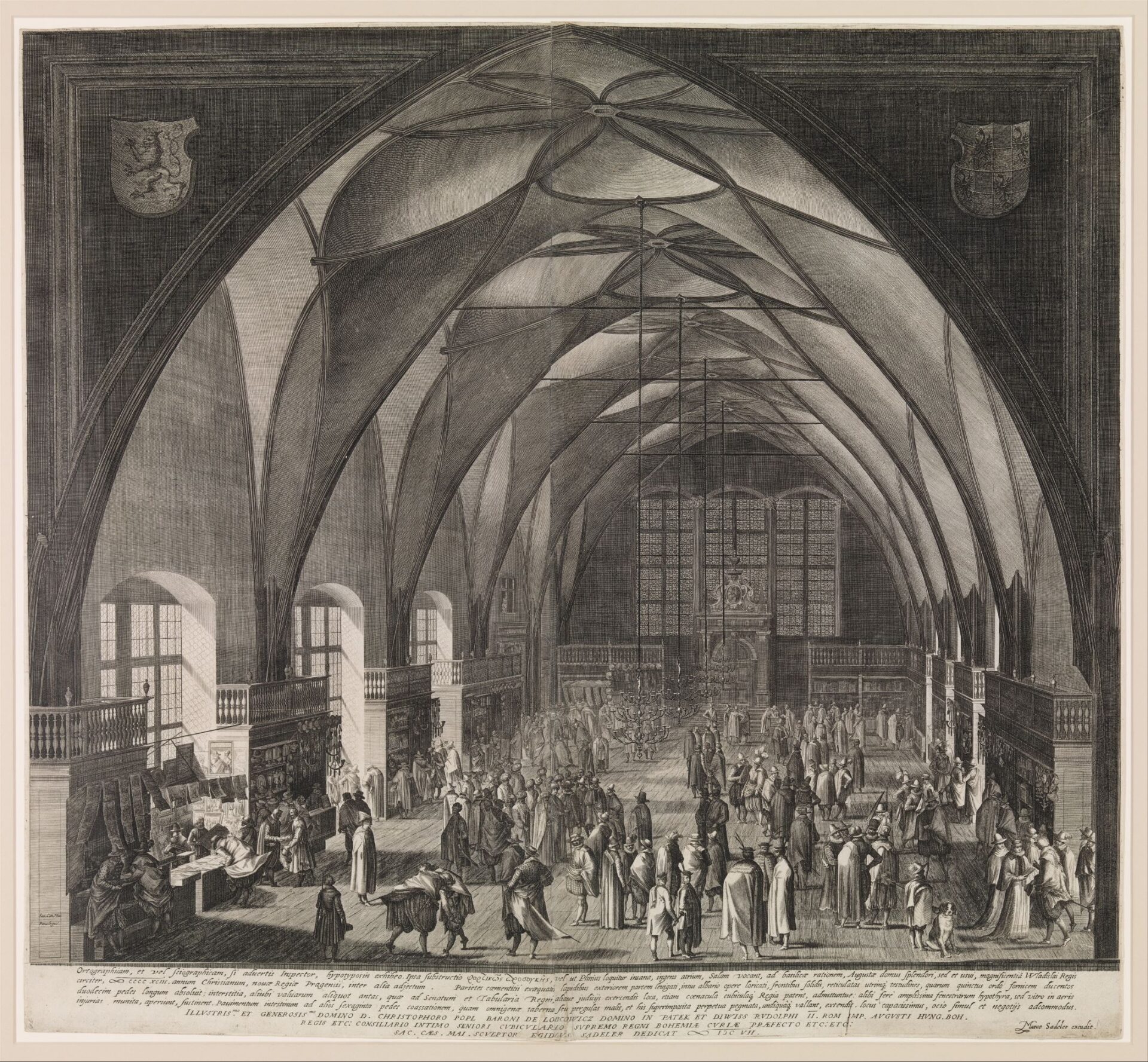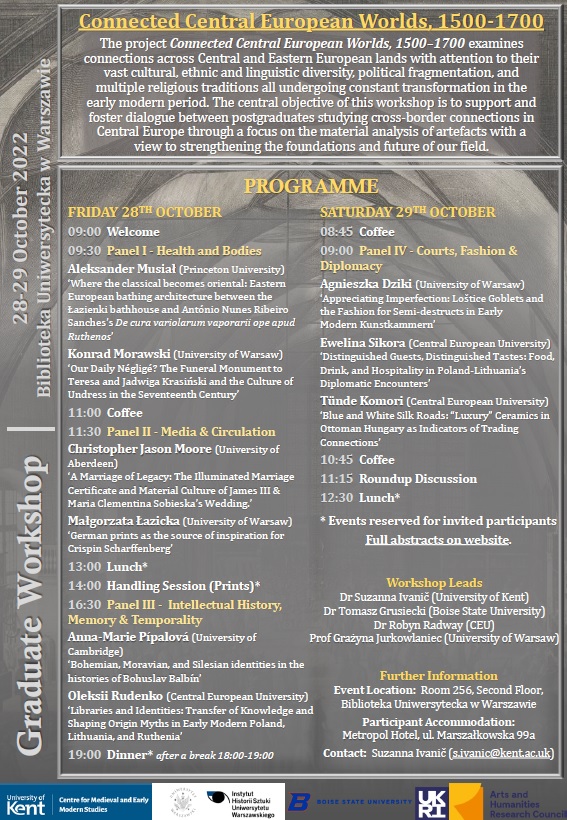28-29 October 2022 ~ University of Warsaw, Institute of the History of Art, Poland.
A workshop for postgraduate students and early career researchers undertaking research on Central and Eastern Europe with a focus on its material connections.
Papers
I Health and Bodies
Aleksander Musiał (Princeton University)
Where the classical becomes oriental: Eastern European bathing architecture between the Łazienki bathhouse and António Nunes Ribeiro Sanches’s De cura variolarum vaporarii ope apud Ruthenos
The paper will examine the ideological implications of shaping Eastern European bodies and identities within the architectural confinements of élite and public baths in the 18th century. An object of unprecedented scholarly, entrepreneurial, and artistic attention, bathhouses in the region served both to articulate their commissioners’ self-fashioning and provided an illuminating case study within the changing notions of bodily physiology, on both practical and theoretical levels. By putting in a cross-national dialogue Warsaw’s rare surviving case-study with the influential scientific account of Ruthenian baths from the 1770s, I will re-examine the relationship between classicizing imagery evoked and orientalizing perceptions of bathing practices activated within such a framework. By disrupting both the oppositions of ancient vs. modern, and the West vs. the East, I will question the agency dynamics within the dominant scholarly narratives on ‘inventing Eastern Europe’ by drawing attention to the period’s emerging primitivising discourse of anti-occidentalism.
Konrad Morawski (University of Warsaw)
Our Daily Négligé? The Funeral Monument to Teresa and Jadwiga Krasiński and the Culture of Undress in the Seventeenth CenturyThe monument to Teresa Krasińska née Chodkiewicz and Jadwiga Krasińska née Jabłonowska in Krasne belongs to a small group of sepulchral monuments in which deceased women are depicted in undergarments. These works of art testify to the sophisticated European culture of the late 17th century, and the traditions behind them seem diverse. Firstly, underwear or nightgowns correspond to the traditional concept of sleep as the image of death. Secondly, chemises and bare feet or sandals fit not only in the early modern perception of loose robes of timeless ‘Roman attire’ but also in the use of the motif of a nymph in the pastoral tradition. Finally, the prevalence of déshabillé popularised by fashion prints corresponds with the public-private nature of a bed of that time. It seems that undergarments may have been part of women’s autonomous self-representation where French culture was strongly influential. At the same time, depending on the context, négligé can be only an aesthetic testimony of a male perspective on femininity (also after death).
II Media and Circulation
Christoph Moore de Torrealba (University of Aberdeen)
The Marriage Certificate of James III & Maria Clementina Sobieska: A Marriage of Legacy.
Małgorzata Łazicka (University of Warsaw)
German prints as the source of inspiration for Crispin Scharffenberg
Imitating works of other artists was the basis of artistic education and a common practice in the sixteenth-century graphic arts. Throughout his whole life, both as a young formschneider in Cracow and as the owner of the printing house in Wrocław, Crispin Scharffenberg based his woodcuts on other prints, especially these made by German printers such as Master IS, Hans Springinklee, Erhard Schön, Sebald Beham, Georg Pencz, Hans Brosamer or Albrecht Dürer. Even though the technical quality of his woodcuts was not as good as of the copied prints, he tried to imitate each artist’s individual style as faithfully as he could. Therefore, his graphic oeuvre was quite diversified. In order to improve the technical aspect of his works he used bigger woodblocks and, sometimes, simplified more complicated elements of the architecture. Nevertheless, by copying other masters’ works Scharffenberg contributed to the dissemination of new iconographical and compositional schemata.
III Intellectual History, Memory and Temporality
Anna-Marie Pípalová (University of Cambridge)
Bohemian, Moravian, and Silesian identities in the histories of Bohuslav Balbín
Following the widespread politico-religious changes which occurred in Bohemia during and after the Thirty Years’ War, Bohemia experienced an outpouring of new historical works about the polity. Many of these works were written with a ‘patriotic’ and Catholic message, uniting a defence of Bohemia against its detractors while championing the victory of Catholicism and the Habsburgs. Among Bohemia’s most prominent historians in this period was Bohuslav Balbín (1621-1688), a Jesuit, scholar, and noble. This contribution will assess the ways in which Balbín approached the Bohemian monarchy as a whole and how he defined its identity, as well as how he portrayed the links between the different constituent territories of that monarchy. It will consider the role which Balbín assigned to the Virgin Mary and her links to the landscapes and identities of Bohemia, Moravia, and Silesia, as well as figures such as Charles IV and the Bohemian forefather Čech.
Oleksii Rudenko (Central European University)
Libraries and Identities: Transfer of Knowledge and Shaping Origin Myths in Early Modern Poland, Lithuania, and Ruthenia
What can the composition of a Renaissance library suggest about someone’s interests and identity? In early modern East-Central Europe, private and institutional libraries were integral parts of knowledge production and history-writing. My exploration of the Cathedral Chapters’ and University’s libraries, as well as professorial and aristocratic collections unveil some practices in book collection and exchange of knowledge that were not considered before. In this paper, I compare and disentangle the principles of composition of several key libraries of the sixteenth century – Kraków and Vilnius Cathedral Chapters, Maciej Miechowita’s and Maciej Stryjkowski’s library, and several Lviv and monasterial libraries in Ruthenian lands. My key argument underlines the hidden impact that the books, their structures, narratives, and fables had on history-writing in Poland, Lithuania, and Ruthenia, and in particular on the origin myths of their people. I emphasize the role of the classical authors whose presence in the libraries was not merely a tribute to Renaissance fashion but a notable template of history-writing and myth-creation in the lands of multicultural Commonwealth.
IV Courts, Fashion and Diplomacy
Agnieszka Dziki (University of Warsaw)
Appreciating Imperfection: Loštice Goblets and the Fashion for Semi-destructs in Early Modern Kunstkammer
The aim of this paper is to analyze the presence of partly damaged and imperfect objects in the space of the Kunstkammer, which, I argue, existed as a part of a larger phenomenon of collecting incompleteness. Taking advantage of technical shortcomings and turning them into an aesthetic value is a distinguishing feature of the Loštice goblets – nodules on the surface and rough texture are regarded as potters’ reaction against the manufacture of high-quality tin vessels and glass. Physical properties of clay: the lack of lightness, lustre and durability were supplemented with the intriguing effect of a quasi-damaged object. Base, body and rim have often been edged with silver, as a way of ennobling a faulty product. It was also the case of an incomplete figure of Madonna – Hans Leinberger’s seemingly unsuccessful approach to the unrecognised properties of bronze – which offered a disturbing comment on the Beautiful Maria of Regensburg.
Ewelina Sikora (Central European University)
Distinguished Guests, Distinguished Tastes: Food, Drink, and Hospitality in Poland-Lithuania’s Diplomatic Encounters
In Compendium ferculorum or the collection of dishes (1682), arguably the first intentional codification of Polish cuisine, Stanisław Czarniecki recommends to “satisfy French legates with French dishes, German with German, Italian with Italian, Polish with Polish.” Voivode Stanisław Kazimierz Bieniewski, before his legation to Muscovy in 1667, bought impressive amounts of sweets and fragrant vodkas. In 1677, a member of the grand embassy to the Sublime Porte headed by Voivode Jan Gniński noted down that while approaching Serasker Ibrahim Pasha’s military camp near the Danube, they were sent ahead lamb, mutton, bread, cucumbers, cherries, jars of sherbet, and ice along with a running order of food provisions for the following stages of their journey. Relying on examples selected from the Polish-Lithuanian source material, I want to invite you to consider the significance of hospitality centered around the table, particularly the one set for diplomats. It is clear that food and drink was an integral part of both high-profile encounters and the daily life of diplomats, whether offered during reception banquets, presented as gifts, or handed as provisions, but what does it bring to the story about early modern diplomacy?
Tünde Komori (Central European University)
Blue and White Silk Roads: “Luxury” Ceramics in Ottoman Hungary as Indicators of Trading Connections
Shortly after being formed as a sultanate and taking control of a significant part of Anatolia, the Ottomans started expanding their influence towards Europe as early as the fourteenth century, first occupying the Balkans, and by the mid-sixteenth century, Buda as well. The second half of the sixteenth century saw a significant part of the medieval Hungarian Kingdom fall into Ottoman hands, holding onto them until the end of the seventeenth century. The arrival of this new Central Asian culture brought, among countless others, a new material cultural element: the blue and white (or in case of Iznik ware, polychrome) “luxury” ceramics. These vessels were either made of Chinese porcelain, or Anatolian and Persian faience; all high-quality, and probably expensive materials. The remains of these objects are one of the most informative types of Ottoman-period archaeological finds in the Balkan region and Hungary. Their analysis provides a deeper understanding of the trading connections within and outside the early modern Ottoman Empire, shedding light on aspects such as the Ottomans in the Indian Ocean or the legacy of the Levant carried on by traders of the Empire.

